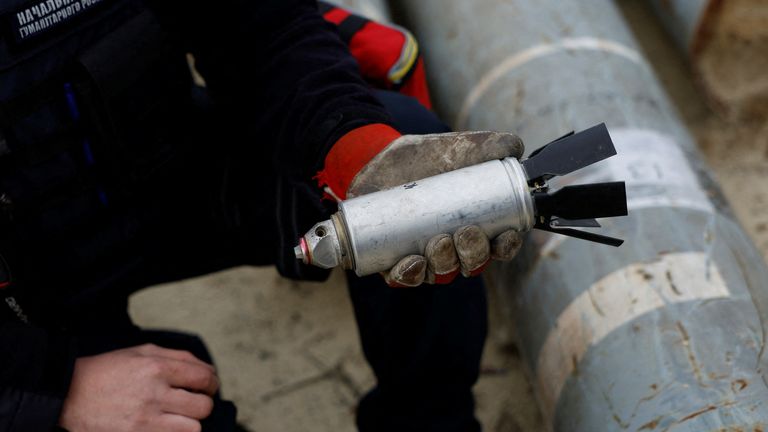President Biden has agreed to give Ukraine controversial cluster munitions to use against Russian troops.
Thousands will be sent as part of a new US aid package worth hundreds of millions of dollars.
Cluster munitions detonate in the air and release smaller “bomblets” that scatter over a large area.
Ukraine war latest: Deadly blast at Russian explosives factory
Opponents say they kill indiscriminately and that some of the smaller munitions can fail to detonate, posing a long-term risk to civilians.
US officials said the cluster bombs it will provide have a low “dud rate” to minimise the risk.
Colin Kahl, undersecretary of defence for policy, said it would only provide ones with a failure rate under 2.35%.
He said “hundreds of thousands” were potentially available, but refused to state how many would initially be provided.
Mr Kahl said Russia had been using older cluster munitions with a dud rate of 30-40% in Ukraine since the start of the war.
Ukraine is said to have given assurances not to use them in populated environments, to map where they are used, and committed to a post-war clean up.
NATO Secretary-General Jens Stoltenberg said the alliance took no position on the issue and that it’s for “individual allies then to make those decisions”.
However, the United Nations has urged both sides not to use them.
Read more:
The training facility where Wagner Group fighters ‘would be welcome’
Wagner troops leave Central African Republic after ‘refusing contracts with Russia’
UN human rights office spokesperson Marta Hurtado said “the use of such munitions should stop immediately and not be used in any place”.
The International Red Cross said cluster munitions “cause significant numbers of preventable civilian casualties”.
More than 120 countries are signed up to a convention against the use and manufacture of cluster bombs, but the US, Russia and Ukraine are not part of it.
Oleksandra Ustinova, a member of Ukraine’s parliament, is one of those supporting the weapon’s use.
She said troops already had to disable mines when they regain territory and could catch any unexploded bomblets as part of that.
“We will have to de-mine anyway, but it’s better to have this capability,” she said.
Sky defence analyst Sean Bell said Ukraine had to make a judgement about “the benefits of these weapons, which could provide a decisive capability in this war, versus the risk of the legacy they’re going to inherit of having to clear up these up”.
The last large-scale US use of the weapon was in Iraq in 2003.
However, Human Rights Watch estimates the American-led coalition also used 1,500 cluster bombs in the first three years of the Afghanistan war.
The cluster bombs being sent to Ukraine are part of another tranche of weapons and artillery that the US says brings its total arms contribution to $41.3bn.
